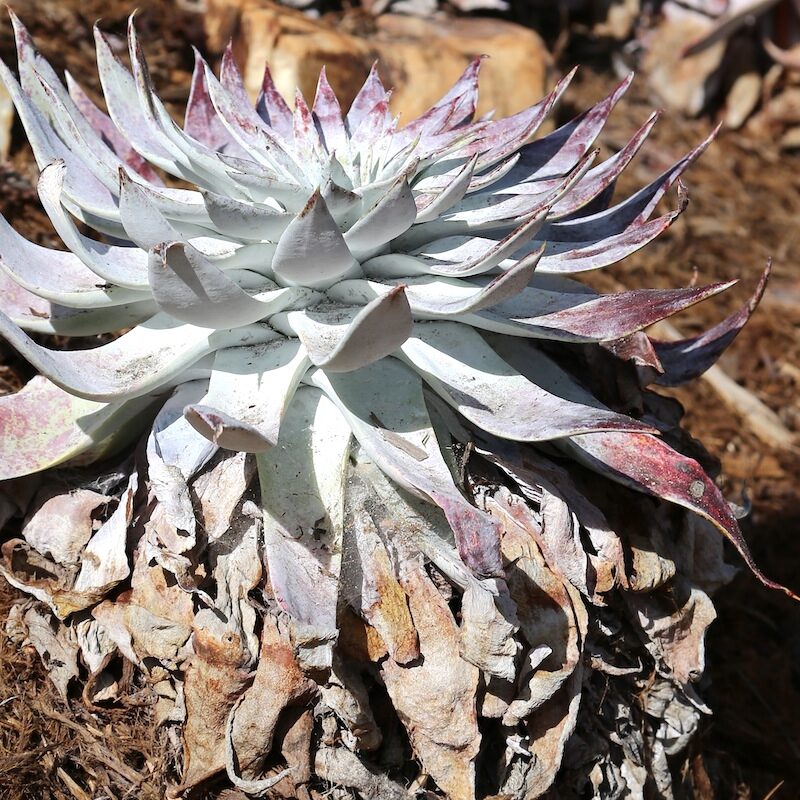About This Q&A Page ...
Many readers have questions about growing and caring for succulents, and I often get asked similar questions many times. On this page, I've pulled together answers to many of the common questions. There are also answers to questions about interesting, unusual or good-to-know topics. I've sorted them by topic area for your convenience but I encourage you to browse through them all; you never know what you might learn!
For detailed FAQs on all succulent topics, see the Succulent Care Basics page.
Succulent Basics

Great question! It’s challenging for you to grow most of these plants in anything but a climate-controlled greenhouse. The problem is not the heat but humidity, dampness and summer rainfall. These are dry-climate plants adapted to living off the moisture in their leaves during periods of drought. They don’t know what to do with excess moisture. Pests and problems set in—like fungus, mildew and rot.
There are, however, tropical succulents that you might try—such as hoya—but even those won’t be able to handle your cold winters.
But I’m no expert in the horticulture of South Georgia. The best things to do is to talk to members of your closest Cactus & Succulent Society chapter, observe what’s growing in neighbor’s gardens, and see what’s available in local nurseries.

Watering Succulents

About once a week should do it.
Water more during hot, dry spells and less or not at all during periods of high humidity, cool temperatures, or rain.
Also, the fatter the succulent or the fleshier its leaves, the more water it stores in its tissues and the less often it needs to be watered (and the less water it will tolerate).
Cacti in general are less tolerant of overwatering than smooth-leaved succulents; water them less often.
Let the soil dry out (or nearly so). An occasional overwatering won’t harm most succulents providing the soil is fast-draining. If water has collected in a pot saucer, remove it so roots don’t sit in water.
Move potted succulents beneath your home’s eaves. Place patio umbrellas (with concrete bases for stability) in the garden to keep rain from soaking your in-ground succulents. Channel runoff away from garden beds. Move and replant succulents away from low-lying areas where water puddles. Topdress the soil around the plants with several inches of pumice to absorb excess moisture.

Propagating Succulents

So many stem succulents produce aerial roots, it’s difficult to generalize, but if you keep in mind that roots want to be in the ground, that’ll help.
Although the rule of thumb is to only cut as much stem as needed for the cutting to stand upright when planted, I sometimes will dig a shallow trench and lay a longer cutting that’s feathered with aerial roots into it, root side down, then bury it with the rosette at the tip above the soil.
As with most succulents, it's always a good idea to let it callous before planting (although not the end of the world if you forget)!

Soil & Planting Advice for Succulents

No. Ironite is for lush green growth come spring, and is primarily for newly installed, in-ground plants.
Let your potted succulents rest over the winter and feed them in the spring.

Succulent Pests & Problems

If you live in an area where predators like coyotes are kept out (like a gated community), bunnies and squirrels may be prolific. Some measures that can help include:
- Installing an owl box;
- dusting the plants with crushed red chilis or
- spraying a squirrel repellent.
Also there are solar- and battery-powered electronic devices that emit a high-frequency sound that repels squirrels and the like. This one, for about $30 on Amazon, can be set for cats, dogs, skunks, squirrels and raccoons.
Around the bases of barrels I spread “pre-emergent,” a granular herbicide that prevents weeds from germinating. (One brand is Preen.) You have to apply it before the rains, because once weeds sprout, it’s too late. I wouldn’t be without it.
As to its environmental impact, I checked with the director of horticulture at the San Diego Botanic Garden, and he’s fine with it, in fact, they use it too. But if you're concerned, try a natural alternative like corn gluten. It's not as effective and takes more applications, but it can help prevent many weeds from germinating.
If you already have weeds, extract them with long-handled tweezers, a hand weeder with a V-shaped metal tip, or—recommended by the Ruth Bancroft Garden for weeding around cactus—a Stainless Steel Fish Hook Remover Extractor, around $8 on Amazon.
Leaf tip desiccation is usually an aftermath of frost or scorching sun. It can also be related to under-watering…the plant can’t manage to pump water all the way to the tips (not enough hydraulic pressure).
Succulent tip browning is not caused by overwatering…that’s when the core rots, not the tips.
Some species are prone to leaf-tip desiccation, especially spotted ones (A. maculata and hybrids) and IMHO the way the dry tips curl looks kind of cool.
If you don't like the look, you can cut off the dried up tips. When trimming any pointed succulent leaf (including agaves), make two cuts to create an outward-pointing “V,” so the cut isn’t as noticeable as straight across

Floral Arrangements, Centerpieces & Succulent Crafts

It depends on what you’re making and the time of year (succulents root faster in the spring), but you could pot them 2-3 weeks prior. This will give them sufficient time to recover and root so that they are thriving and looking gorgeous on the day of the event.
Just make sure they get adequate light so they keep their color and form. Without several hours of bright (not hot) sun daily, rosette succulents will flatten and those with stems will elongate, potentially spoiling the symmetry of the composition. However, cuttings are also more prone to sunburn, which could be disastrous.
If this is more of a floral arrangement than a potted one, I’d wait until immediately prior. Cuttings don’t need to root to look good, they’ll be at peak color and best form, and they'll have enough moisture in their tissues so they don’t wilt. They’re fine without soil so you don’t have to deal with wet dirt and saucers under pots at the event. Plus, they weigh less too.

Can You ID My Succulent?
The volume of email I receive makes this difficult. The good news is I'm working on website pages for each genus. Here are the types of succulents I've covered so far (with lots of photos and labels for each plant with full details):
Moreover, the hundreds of succulents shown in my books are ID'd in the captions.
There's a lot of inaccuracies about succulents online, but San Marcos Growers site is a reliable one for IDs and descriptions.
MORE INFORMATION...
Companion plants (those with similar cultivation requirements as succulents) have an entire chapter in Designing with Succulents.
Practical aspects of landscaping are covered in Designing with Succulents (except for complexities best left to architects and contractors: structures, grading, retaining walls, irrigation installation, water features, etc.)
Learn about exceptional public and private succulent gardens, what's trending in container garden design, my own gardening experiences, and interviews with succulent experts and designers in succulent articles here on my website.
Please subscribe to my newsletter (click "Sign me up!" below), "like" my Facebook pages (Debra Lee Baldwin author and Succulent Container Gardens), follow me on Instagram (@debralbaldwin) and enjoy the 100+ videos on my YouTube channel.
In San Diego or planning a visit? See my list of San Diego succulent destinations and nurseries.
For specific advice regarding succulents that thrive in your area and how to care for them, contact your local chapter of the Cactus & Succulent Society of America.
